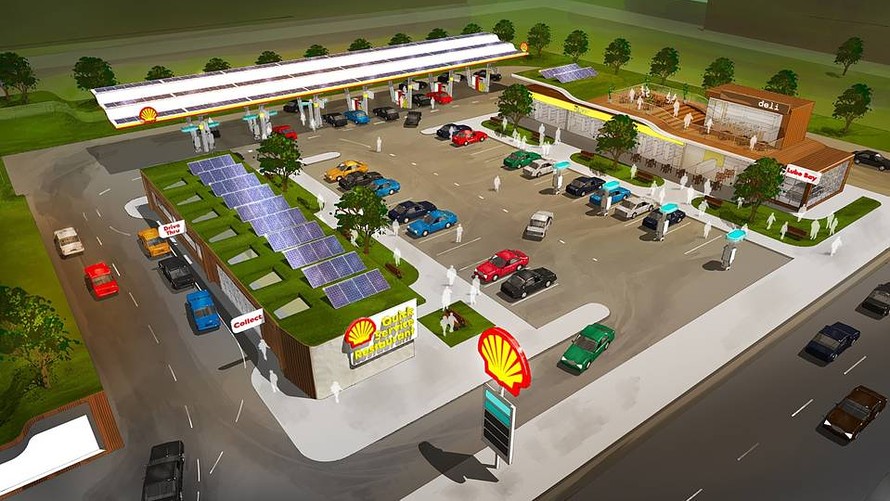What Will Fuel Stations Look Like in the Future?
In the “Petrol Station of the Future” study, German fuel retailer Aral and the Institute for Transport Research of the German Aerospace Center (DLR) investigated how driving performance, vehicle fleets, and their types of propulsion and mobility behavior in Germany will change in 2040.
Additionally, the study looked at the role fueling stations will play in the future. City fueling stations will experience a transformation with the addition of new services for autonomous vehicle fleets, air taxis, and a growing number of electric cars. Experts looked at four types of environments: the big city, the rural area, the urban district, and the motorway.
The need for mobility will grow, according to the study. In 2040, DLR predicts the Germans will travel around 900 billion kilometers per year by car and commercial vehicle – an increase by around 24% compared with 2010.
According to the study, commercial vehicles will double their mileage by 2040 (around 200 billion kilometers) due to the growing e-commerce business and the increasing mileage of freight traffic (more than 87%). Private car traffic is the only segment that will decrease (5%).
In 2040, more passenger vehicles will be powered by hybrid systems. Gasoline and diesel hybrids will make up the largest share of total car ownership at 68% while plug-in hybrids will increase by 28%. Diesel or petrol-powered vehicles will account for two-thirds of the total vehicles. Additionally, electrification will continue to grow with 1.3 million electric vehicles expected to be on German roads.
For filling stations, the three classic pillars (fuel, shop, and car wash) will remain, but they will adjust to technological advances and changing customers’ needs.
“The filling station will certainly continue to play an important role in our mobility in the future,” said Barbara Lenz, director of the DLR Institute for Transport Research. “With new functions, it can become a hub in our everyday lives.”
Fuel stations will see a drop in the number of fuel pumps and instead add more charging stations, especially the ultra-fast charging columns that can charge cars in five minutes for a range up to 145 kilometers. Fuel stations will use tank robots for refueling and charging vehicles. Stations will also offer natural gas and LPG fuel options.
“We will continue to score points in the coming decades with further developed high-quality fuels that increasingly contain bio-components or synthetic fuels, and thus be able to make an important contribution to the growing mobility of our society,” says Patrick Wendeler, CEO of Aral.
At filling stations, autonomous vehicles could carry goods from the store to the home via “home delivery.” In a station’s café area, customers could choose from a variety of food options. The station can also provide customers with pooling vehicles to continue the rest of their journey.
New mobility trends will be available at fueling stations in the big city. With the increased use of autonomous vehicles, filling stations could provide services for autonomous vehicles. In addition to being serviced and cleaned there, autonomous vehicles (from fleet operators) will be available on call.
For the increase in e-bikes and e-scooters, battery charging machines will be available at fueling stations. Private drivers and commercial delivery services could exchange empty batteries for charged ones. Another new service could be offering meeting rooms and mobile offices for businesspeople.
In rural areas, keeping your own car is central to mobility, especially as the routes to be driven are getting longer due to a thinning infrastructure. Fueling stations could act as a social meeting place as well as offer parcel services. Commercial drivers could take deliveries for their customers from the station’s parcel center.
Source: https://www.fleetforward.com
FLEET MANAGEMENT AUDIT
Fleet management is the use of a set of vehicles in order to provide services to a third-party, or to perform a task for our organization, in the most efficient and productive manner with a determined level of service and cost.
Fleet management activities are shown in the following graph 1:

Graph 1: fleet management activities
The proposal audit analyses and assesses all fleet management activities shown in the graph 1, and its main goals are:
- Know the overall status of the fleet management activities
- Provide the analysis, the assessment, the advice, the suggestions and the actions to take in order to cut costs and increase the efficiency and efficacy of the fleet management activities
With the information obtained, we’ll elaborate a report that holds the overall status of the fleet management as well as the suggestions, recommendations and the measures to take in order to cut costs and optimize the fleet management activities.
CLICK ON THE FOLLOWING LINK TO DOWNLOAD THE PROPOSED FLEET MANAGEMENT AUDIT:
Fleet Management Audit AFMC
Contact:
José Miguel Fernández Gómez
34 678254874



